More than 100 insurance companies are suing ERCOT and power generators for their policy holders’ “significant property damage” during last February’s winter storm, adding to the mountain of legal woes facing the Texas grid operator.
The 137 companies banded together to file their lawsuit Dec. 28 in the Travis County District Court’s 459th Judicial District and asked for a jury trial (D-1-GN-21-007413).
They included as defendants 37 “power generation companies” — from industry heavyweights Luminant and NRG Energy down to individual wind farms — for failing to prepare for the 2020-2021 winter season by adhering to voluntary weatherization standards.
The insurance companies charge that ERCOT and the generators were “at fault” for the dayslong power outages that resulted in hundreds of deaths and billions in property damage. According to a report from the Texas Department of Insurance, insurers have received more than 500,000 claims stemming from the winter storm. The report estimated that, as of July 2021, the companies will have to pay about $10.3 billion in losses.
The lawsuit said that while ERCOT has conducted weatherization-compliance spot checks since 2013, staff would regularly find that 25 to 35% of the generators were deficient and/or not complying with weatherization rules.
“ERCOT and the [generators’] unwillingness to accept or adopt any minimum weatherization standards runs contrary to the common law of Texas,” the insurance companies said.
According to the lawsuit, Texas courts hold electric companies to the burden of showing they exercise “due care” in supervising and maintaining their facilities. It cited precedent that the interruption of service is not an event “that occurs without a cause.”
“When a power failure occurs, there is a defect somewhere says,” the lawsuit said.
ERCOT did not respond to a request for comment. However, the grid operator has consistently claimed sovereign immunity when sued, noting it is funded by generators’ transaction fees.
The issue could be decided in two unrelated cases before different state appellate courts. ERCOT is battling San Antonio municipality CPS Energy in the Fourth Court of Appeals over charges of “exorbitantly high, illegal” wholesale costs during the storm. (See CPS Energy Wins Round 1 vs. ERCOT.)
Separately, the Fifth Court of Appeals in Dallas has heard arguments over a 2016 complaint against ERCOT by Panda Power Generation Infrastructure Fund. Panda argues that it spent $2.2 billion to build three new power plants based on the grid operator’s faulty and misleading projections of the state’s future energy needs.
The Texas Supreme Court last March declined to review an appellate ruling granting ERCOT immunity from lawsuits. (See Texas Supremes Sidestep Ruling on ERCOT Lawsuit Shield.)
In other litigation, more than 400 Texans have filed 170 lawsuits against ERCOT and utilities over the February outages. The state officially lists the death toll at 246.
Gas Production Drops Again
FERC, NERC, academia and the electric industry have reached consensus that February’s outages were mostly from gas infrastructure’s lack of winterization, which reduced fuel supplies to gas-fired generation units. (See FERC, NERC Release Final Texas Storm Report.)
This past weekend, gas supplies again dropped during Texas’ first cold snap of the season. Bloomberg said gas production in West Texas’ Permian Basin fell to its lowest levels since last February, leading to the loss of more than 10% of ERCOT’s generation.
Naturally, that raised questions among industry experts and observers.
“Yes, poor performance of gas suppliers last weekend ‘raises questions,’ but more importantly, it provides answers,” tweeted Stoic Energy President Doug Lewin. “The answers are they didn’t winterize; they’re not ready; and Texans are again vulnerable if there’s another extreme cold snap like 2011 or 2021.”
Lewin is among those who have criticized the gas industry’s lack of winterization, saying the electric industry’s more robust winterization practices are rendered useless when gas doesn’t flow. (See ERCOT, PUC Say Grid is Ready for Winter Weather.)
The Texas Railroad Commission, which regulates the state’s natural gas industry, has not required gas facilities to winterize this winter, as has the electric industry. Gas companies can also opt-out by paying a $150 fee and asking for an exemption. The gas network is being mapped to determine those facilities critical to power production, but that process isn’t expected to be finished until 2023.
The cross-industry group working on the study have filed a progress report with the Public Utility Commission. It lists several best practices that “should be implemented … to prepare facilities providing natural gas critical to the electricity supply chain to maintain service in an extreme weather event.”

